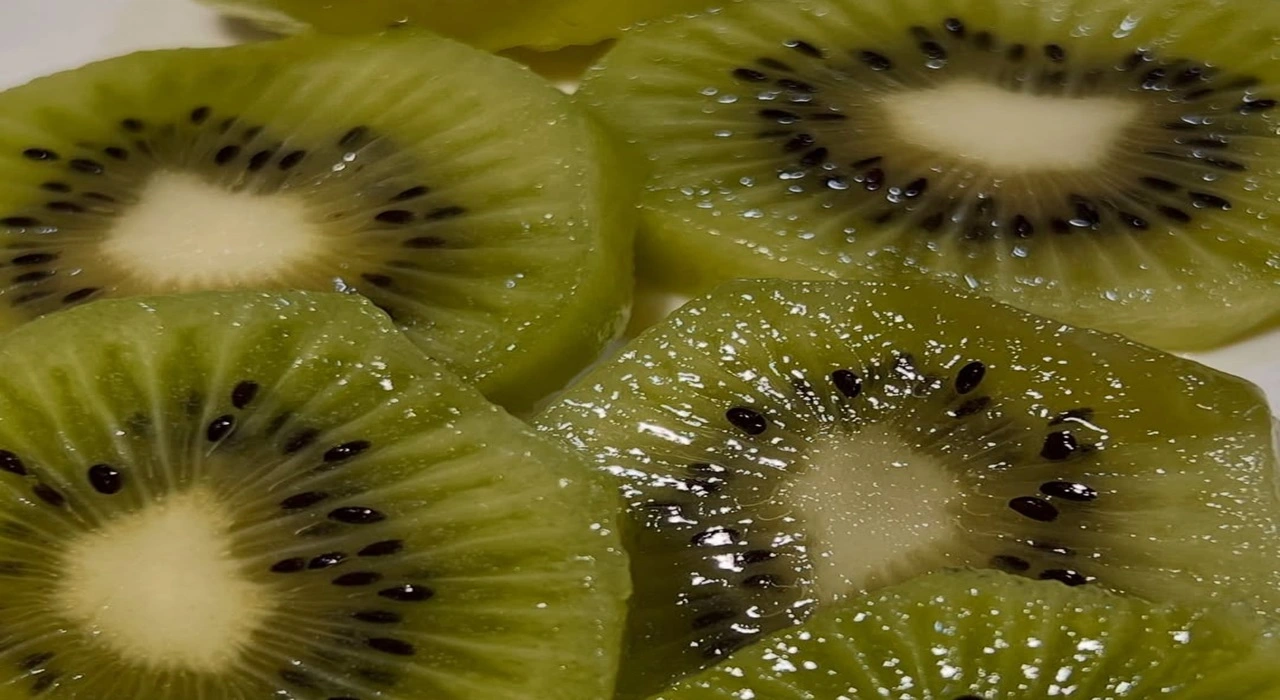Introduction
When you think of Kiwi Fruit, the first thing that probably comes to mind is its bright green colour and refreshing taste. But this little fruit, often called the “Chinese gooseberry,” is packed with nutrients, antioxidants, and flavour. Whether you enjoy it sliced in a salad or blended into a smoothie, Kiwi Fruit is a delicious way to boost your health. Let’s explore why this fruit deserves a spot in your daily diet!

What is a Kiwi Fruit?
Kiwi Fruit is a small, oval-shaped fruit that originated in China but is now grown in many parts of the world, including New Zealand, Italy, and even California. Its fuzzy brown skin hides a vibrant green or golden flesh filled with tiny black seeds. The taste is a perfect balance of sweet and tangy, making it a favourite among fruit lovers.
Interestingly, Kiwi is not just known for its flavour but also for its impressive health benefits. One medium sized Kiwi has about 42 calories but offers a powerhouse of vitamins, minerals, and fiber.
Nutritional Value of Kiwi Fruit
Here’s a quick look at what you get from one medium-sized Kiwi:
- Vitamin C: More than 100% of the daily recommended intake
- Vitamin K: Good for bone health
- Fiber: Helps digestion
- Potassium: Supports heart health
- Antioxidants: Protect cells from damage
Thanks to its rich nutritional profile, eating Kiwi regularly can do wonders for your body.

Health Benefits of Kiwi Fruit
1. Boosts Immunity
One of the standout features of Kiwi is its exceptionally high Vitamin C content. Vitamin C is crucial for a strong immune system. Regular consumption can help your body fight off infections and reduce the severity of colds and flu.
2. Aids Digestion
Kiwi Fruit is a natural source of fiber and an enzyme called actinidin, which helps break down proteins in the digestive system. If you often suffer from bloating or indigestion, adding Kiwi to your meals might help.
3. Supports Heart Health
The potassium in Kiwi helps manage blood pressure by balancing out the negative effects of sodium. Moreover, the antioxidants and fiber in Kiwi contribute to lower cholesterol levels, supporting overall heart health.
4. Improves Skin Health
Vitamin C is not just good for your immune system; it also plays a key role in collagen production. Collagen keeps your skin firm and youthful. Eating Kiwi regularly may help reduce wrinkles and keep your skin glowing.
5. Helps in Weight Management
Looking to shed a few pounds? Kiwi is low in calories but rich in fiber, making it a perfect snack for weight watchers. It keeps you full longer and curbs unhealthy cravings.
How to Eat Kiwi Fruit
There are many fun and tasty ways to enjoy Kiwi Fruit:
- Eat it raw: Simply peel and slice.
- Add to smoothies: Blend it with bananas and yogurt.
- Toss into salads: Adds a sweet-tart flavor.
- Top your desserts: Use it to decorate cakes and tarts.
- Make a salsa: Combine diced Kiwi with tomatoes and cilantro for a unique salsa.
Don’t want to peel it? You can actually eat the skin! It’s full of fiber, although it may feel a little fuzzy.
Fun Facts About Kiwi Fruit
- Kiwi was originally called the Chinese gooseberry.
- New Zealand farmers renamed it “Kiwi” after their native bird, which is also small, brown, and fuzzy.
- Golden Kiwi varieties are smoother and sweeter compared to the green ones.
How to Choose and Store Kiwi Fruit
When buying Kiwi, look for fruits that are slightly soft to the touch but not mushy. A firmer Kiwi will ripen at room temperature within a few days. Once ripe, you can store it in the refrigerator to keep it fresh longer.
Potential Side Effects of Kiwi Fruit
Although Kiwi is safe for most people, some might experience allergic reactions like itching in the mouth, swelling, or skin rashes. If you’re allergic to latex, you might be more prone to a Kiwi allergy as well.
It’s always best to try a small amount first if you’ve never eaten Kiwi before.
Frequently Asked Questions (FAQs) about Kiwi Fruit
Q1. How many Kiwis should I eat a day?
Eating 1-2 Kiwis per day can give you plenty of Vitamin C and fiber. However, there’s no strict limit unless you have an allergy or digestive sensitivity.
Q2. Can I eat Kiwi skin?
Yes! The skin of Kiwi is edible and packed with nutrients, especially fiber. Just make sure to wash it thoroughly before eating.
Q3. Is Kiwi good for diabetics?
Kiwi has a low glycemic index, meaning it doesn’t spike blood sugar levels quickly. It can be a healthy choice for people managing diabetes.
Q4. What is the best time to eat Kiwi?
You can enjoy Kiwi any time of the day. Eating it in the morning can boost your energy, while having it before bed may aid digestion.
Q5. Can Kiwi help with constipation?
Absolutely! The fiber and natural enzymes in Kiwi can promote bowel regularity and help relieve constipation.
Final Thoughts
Kiwi Fruit is a small but mighty fruit that offers a wide range of health benefits. It’s refreshing, nutrient dense, and incredibly versatile in recipes. Whether you want to boost your immunity, improve your digestion, or simply enjoy a tasty snack, Kiwi is an excellent choice.
Next time you’re at the grocery store, grab a few Kiwis your body will thank you!